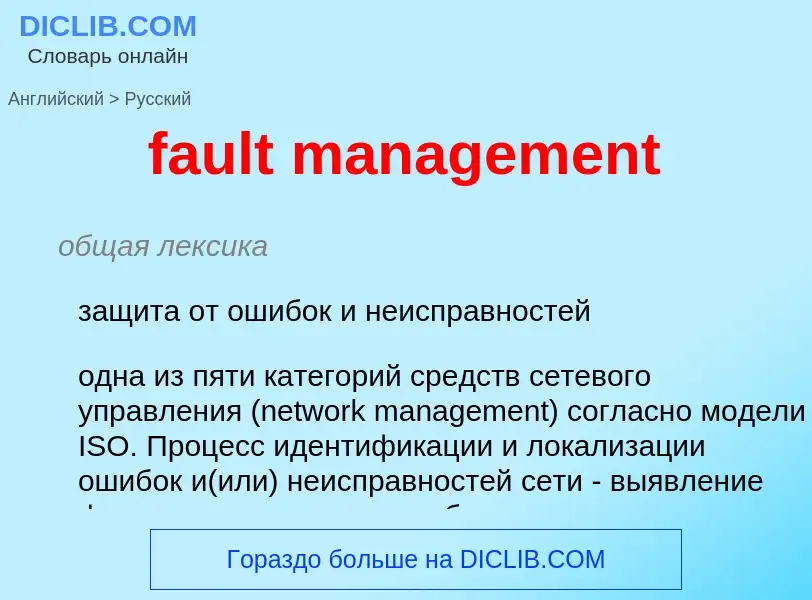Tradução e análise de palavras por inteligência artificial ChatGPT
Nesta página você pode obter uma análise detalhada de uma palavra ou frase, produzida usando a melhor tecnologia de inteligência artificial até o momento:
- como a palavra é usada
- frequência de uso
- é usado com mais frequência na fala oral ou escrita
- opções de tradução de palavras
- exemplos de uso (várias frases com tradução)
- etimologia
fault management - tradução para Inglês
общая лексика
защита от ошибок и неисправностей
одна из пяти категорий средств сетевого управления (network management) согласно модели ISO. Процесс идентификации и локализации ошибок и(или) неисправностей сети - выявление факта существования проблемы, определение ее источника и, возможно, устранение ошибки (или, как минимум, ее изоляция от остальной сети)
Смотрите также
общая лексика
сообщение с землей
Definição
Wikipédia
In network management, fault management is the set of functions that detect, isolate, and correct malfunctions in a telecommunications network, compensate for environmental changes, and include maintaining and examining error logs, accepting and acting on error detection notifications, tracing and identifying faults, carrying out sequences of diagnostics tests, correcting faults, reporting error conditions, and localizing and tracing faults by examining and manipulating database information.
When a fault or event occurs, a network component will often send a notification to the network operator using a protocol such as SNMP. An alarm is a persistent indication of a fault that clears only when the triggering condition has been resolved. A current list of problems occurring on the network component is often kept in the form of an active alarm list such as is defined in RFC 3877, the Alarm MIB. A list of cleared faults is also maintained by most network management systems.
Fault management systems may use complex filtering systems to assign alarms to severity levels. These can range in severity from debug to emergency, as in the syslog protocol. Alternatively, they could use the ITU X.733 Alarm Reporting Function's perceived severity field. This takes on values of cleared, indeterminate, critical, major, minor or warning. Note that the latest version of the syslog protocol draft under development within the IETF includes a mapping between these two different sets of severities. It is considered good practice to send a notification not only when a problem has occurred, but also when it has been resolved. The latter notification would have a severity of clear.
A fault management console allows a network administrator or system operator to monitor events from multiple systems and perform actions based on this information. Ideally, a fault management system should be able to correctly identify events and automatically take action, either launching a program or script to take corrective action, or activating notification software that allows a human to take proper intervention (i.e. send e-mail or SMS text to a mobile phone). Some notification systems also have escalation rules that will notify a chain of individuals based on availability and severity of alarm.

